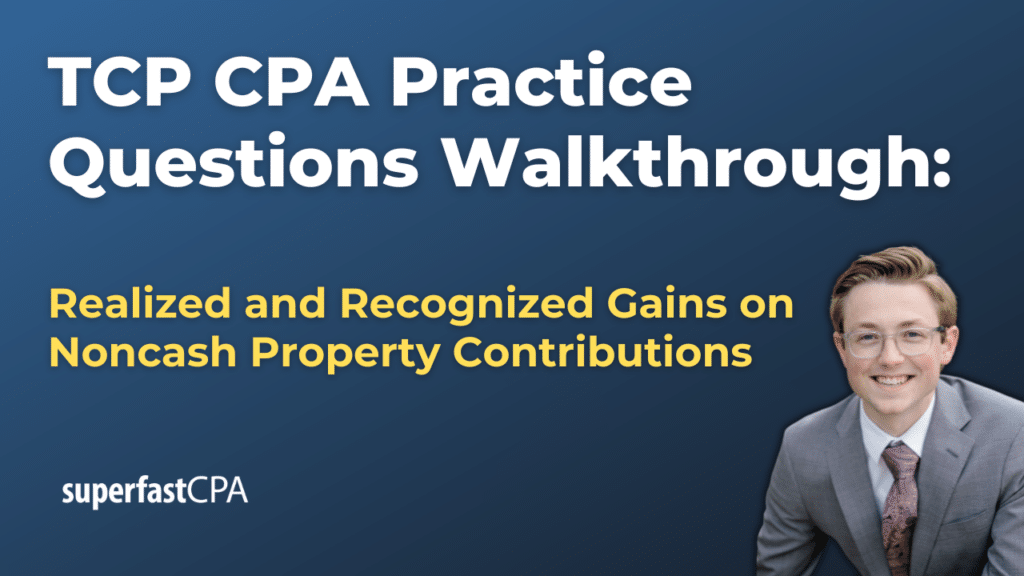In this video, we walk through 5 TCP practice questions teaching about calculating a shareholder’s tax realized and recognized gain on the contribution of noncash property to a C corporation. These questions are from TCP content area 2 on the AICPA CPA exam blueprints: Entity Tax Compliance.
The best way to use this video is to pause each time we get to a new question in the video, and then make your own attempt at the question before watching us go through it.
Also be sure to watch one of our free webinars on the 6 “key ingredients” to an extremely effective & efficient CPA study process here…
Calculating a Shareholder’s Tax Realized and Recognized Gain on the Contribution of Noncash Property
80% Control Rule to Avoid Recognized Gains
One of the fundamental principles in corporate taxation is the 80% control rule, which is crucial for deferring gain recognition on the transfer of noncash property to a corporation. When a shareholder transfers property to a corporation in exchange for stock, no gain or loss is recognized if the transferor, or transferors acting in concert, control at least 80% of the corporation immediately after the exchange. This rule allows shareholders to defer tax on the appreciation of the transferred property until they sell their shares in the corporation.
Multiple Transferors and the 80% Control Rule
The 80% control rule is not limited to single transferors. Multiple transferors can combine their contributions to meet the 80% control requirement. This means that even if an individual transferor does not receive 80% control, as long as the group of transferors collectively holds 80% or more of the corporation’s stock immediately after the exchange, no gain or loss is recognized for any of the transferors.
Example:
Jane and Michael decide to form Horizon Corp. Jane transfers equipment with a fair market value (FMV) of $180,000 and an adjusted basis of $110,000 in exchange for 45% of Horizon Corp’s stock. Michael transfers a warehouse with an FMV of $220,000 and an adjusted basis of $140,000 in exchange for 55% of Horizon Corp’s stock. Together, Jane and Michael own 100% of Horizon Corp, satisfying the 80% control requirement. Therefore, no gain is recognized by either transferor.
Calculating Realized Gain
The realized gain on the transfer of property to a corporation is calculated by subtracting the adjusted basis of the property from the sum of the FMV of the property received (including stock, cash, and any liabilities assumed by the corporation).
Formula: Realized Gain = (FMV of Stock + Cash Received + Liabilities Assumed) – Adjusted Basis
Example:
David transfers a warehouse with an FMV of $400,000 and an adjusted basis of $250,000 to Horizon Corp in exchange for 82% of Horizon Corp’s stock with an FMV of $280,000 and $40,000 in cash. Additionally, Horizon Corp assumes a mortgage of $80,000 on the warehouse.
Realized gain = $280,000 (FMV of stock) + $40,000 (cash) + $80,000 (liabilities assumed) – $250,000 (adjusted basis) = $150,000
Calculating Recognized Gain
The recognized gain is the portion of the realized gain that is subject to tax. When boot (cash or other property) is received in addition to stock, the recognized gain is the lesser of the boot received or the realized gain.
Formula: Recognized Gain = Lesser of Boot Received or Realized Gain
Additionally, a recognized gain can occur when the liability assumed by the corporation exceeds the adjusted basis of the property transferred. The recognized gain is the extent to which the liability assumed exceeds the adjusted basis.
Example:
In the previous example, David received $40,000 in cash as boot. The realized gain was $150,000. Since the cash received ($40,000) is less than the realized gain ($150,000), the recognized gain is $40,000.
If the liability assumed in that example had been higher than the adjusted basis of $250,000, let’s say $260,000, that would mean there would have been a recognized gain of $10,000 from the liability assumed.
Special Case: No 80% Control
If the transferors do not meet the 80% control requirement immediately after the exchange, the entire realized gain is recognized.
Example:
Alice transfers a piece of land with an FMV of $300,000 and an adjusted basis of $180,000 to Gamma Corp in exchange for 75% of Gamma Corp’s stock and $40,000 in cash. Additionally, Gamma Corp assumes a mortgage of $50,000 on the land.
Realized gain = $300,000 (FMV of stock) + $40,000 (cash) + $50,000 (liabilities assumed) – $180,000 (adjusted basis) = $210,000
Since Alice did not gain control of the corporation by obtaining 80% or more of the total value of the stock, the entire realized gain of $210,000 is recognized.
Basis in the Transferred Property
The basis of the property in the hands of the corporation is the same as the adjusted basis in the hands of the transferor, increased by any gain recognized by the transferor on the exchange.
Formula: Corporation’s Basis = Adjusted Basis of Property + Recognized Gain
Example:
Sarah and Tom decide to form S&T Corp. Sarah transfers $80,000 in cash in exchange for 40% of S&T Corp’s stock. Tom transfers machinery with an FMV of $200,000 and an adjusted basis of $150,000 in exchange for 60% of S&T Corp’s stock and $40,000 in cash.
Tom’s realized gain = $200,000 (FMV of stock) + $40,000 (cash) – $150,000 (adjusted basis) = $90,000
Recognized gain = Lesser of $40,000 (boot) or $90,000 (realized gain) = $40,000
S&T Corp’s basis in the machinery = $150,000 (adjusted basis) + $40,000 (recognized gain) = $190,000
Conclusion
Understanding the 80% control rule, the calculation of realized and recognized gains, and the basis of transferred property is crucial for both tax compliance and planning. This overview provides a foundation for these key concepts, illustrated with practical examples to facilitate comprehension and application.













